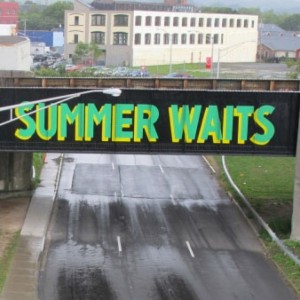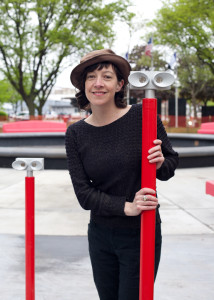Public Art Installations
Approximately $2 million in Connective Corridor funding has been allocated for public art and art initiatives along the new streetscape. This funding comes through grants from ESD, DASNY, the Erie Canal Heritage program and private donors. Arts programming from NYSCA helps activate the Corridor.
Connective Corridor public art projects include:
- Connective Corridor Public Art RFP (currently underway), which is inviting proposals for the commission of permanent works to be installed at various sites along the Corridor. $650,000 has been allocated for the project. Find details here. Read the Connective Corridor RFQ (Interactive) here.
- Syracuse: Sign Here (currently underway), a large scale sign painting project to connect the Near Westside with the Connective Corridor. Work is being solicited that should reflect historic hand painted signs, but also function as contemporary visual anchors, with strong, simple typography and illustrative elements painted at mural scale. $150,000 has been allocated for the project. Read the Sign Painting RFQ (Interactive) here.
- A Love Letter to Syracuse (completed,) which was the foundation for the Sign Here project, produced a series of messages, hand painted by renowned artists Steve Powers, for six sides of three rusted train bridges that connect the Near Westside and the Connective Corridor. The bridges have become iconic symbols of the City’s revival and were featured in Faythe Levine’s documentary, “sign Painters.” See the video here. $120,000 was allocated for the project.
- Syracuse’s first Public Artist in Residence program (completed,) funded and managed through the Connective Corridor, commissioned area artist Brendan Rose to produce four works along the Corridor. $30,000 was allocated for the project. Works included:
>> “Walt, The Loch West Monster,” which was installed where the Onondaga Creekwalk meets the Connective Corridor at Armory Square. Read more here.
>> Two contemporary bell sculptures, which include fragments of historic Syracuse China in their base, installed in front of Grace Episcopal Church and Temple Concord along University Avenue. Read more here.
>> “Lovers’ Bench” stone sculpture by Brendan Rose, installed in the green space on East Fayette Street adjacent to St. Paul’s Episcopal Cathedral. Read more here. - SyraViews (completed), by artist Colleen Wolpert, which features pedestal-mounted stereoscopic viewers commissioned by the Connective Corridor and accepted into the permanent public art collection of the City of Syracuse as part of the Corridor’s restoration of historic Forman Park. The stereoscopes place historic 3D photographs (stereographs) into contemporary outdoor stereoscopic viewers, inviting passersby to peer inside where they are transported into the site as it existed in Victorian times. The three-dimensional view inside the stereoscope aligns with the current cityscape to facilitate a sense of being both “here” and “there: at the same time. Approximately $18,000 was allocated for the project. Read more here.
- Interactive billboard series with Syracuse University VPA Design students (on-going). Can billboards be interactive public art? The Connective Corridor pushed design boundaries with three years of interactive billboard series which integrated original art, photography and video, along with social media and crowdsourcing – designed and executed by VPA School of Design Students. $300 per billboard was allocated for production. The series continues this year. Themes have included:
>> #Iconic Syracuse
>> #DearSyracuseWithLove
>> #InSyracuse
>> #WeAreSyracuse
>> #ExperienceCuse - Bus wraps and on-board mobile galleries (ongoing). Syracuse University VPA students in the School of Design created the designs for exterior bus wraps and custom bus interiors for the Corridor’s free public transportation network. School of Design and School of Architecture students worked with artists to create on-board mobile galleries that regularly rotate original art, photography and graphic design on the buses.
- 40 Below Public Art Task Force Rack Pack (completed), a Connective Corridor call for public art to young artists produced a series of iconic bicycle racks, based on Syracuse history and landmarks, to compliment the bicycle infrastructure being installed along the Corridor. $10,000 was allocated for the project. Read more here.
- Warehouse Mural Project (currently underway), is a call to all Syracuse University School of Design students for two murals on SU’s Nancy Cantor Warehouse in Armory Square – which is the home to the College of Visual and Performing Art’s School of Design. $30,000 is allocated for the project. Read more here.
- Erie Canal Murals (completed):
>> A grand mural capturing the spirit of the Erie Canal, “The Mule Days of Summer” by Buffalo based artist Kelly Curry, was recently installed on the façade of the Erie Canal Museum, funded through the Connective Corridor. The Water Street mural, which overlooks the streetscape that once would have been the Erie Canal, spans six window-like panels and depicts what the famous waterway would have looked like in the 1800s. Approximately $15,000 was allocated (through façade improvement program) for the project. Read more here.
>> “Let Us Continue,” a mural spanning a long wall along the Onondaga Creekwalk by Connective Corridor public art coordinator Quinton Fletchall (SU VPA graduate ’15 and undergraduate ’13, and Connective Corridor engagement scholar) uses vector art in a graphic timeline format to tell the story of Syracuse’s evolving landscape from its earliest days as the powerful Haudenosaunee Native American confederacy through its “renaissance” as a pre-eminent early American industrial city developed through its canal and rail infrastructure, to its evolution and re-emergence as a “legacy” city that is re-inventing itself through civic entrepreneurship. The mural was installed in spring 2015. Approximately $20,000 was allocated for the project.t
>> “S.Alt” — Interactive QR Code Mural by former Syracuse University School of Architecture faculty member, now UC Davis professor of design and principal of Cheng+Snyder, an experimental architecture studio based in Oakland, California. Snyder works at and researches the intersection of architecture, media, and graphics with a particular interest in urban spaces and his work has been exhibited internationally including the 2012 Venice Architecture Biennale. His Connective Corridor mural is a mosaic comprised of QR codes of Syracuse arts, cultural and heritage venues along the Corridor, which reveals itself as a large, building-size scene of an early salt warehouse landing along the Erie Canal. Approximately $10,000 was allocated for the project (through the façade improvement program). - Perseverance Park (currently underway), The Connective Corridor has committed $200,000 toward public art as part of a current solicitation by the Syracuse Urban Renewal Agency for a new public space at the “crossroads” of the Corridor. See the RFQ here.
- A major public art project was the Urban Video Project (UVP), funded with $450,000 in Connective Corridor public art funds. UVP is a multi-media public art initiative of Light Work and Syracuse University that operates one permanent exhibition site and one mobile projection unit along the Connective Corridor. UVP’s mission is to present exhibitions and projects that celebrate the arts and culture of Syracuse and engage artists and the creative community around the world. As an important international venue for the public presentation of video and electronic arts UVP is one of the few projects in the United States dedicated to continuous and ongoing video art projections. UVP Everson is projected onto the famous Everson Museum building and UVP Mobile is a portable high-powered projector unit that can be used to project onto a variety of structures around Syracuse for special events. Read more here.
- A Jenny Holzer 300-square-foot LED curtain that uses 16,000 individual bulbs for graphically-oriented presentations was installed at Syracuse Stage, with programming for it managed by the creative and technical team at Syracuse Stage.


